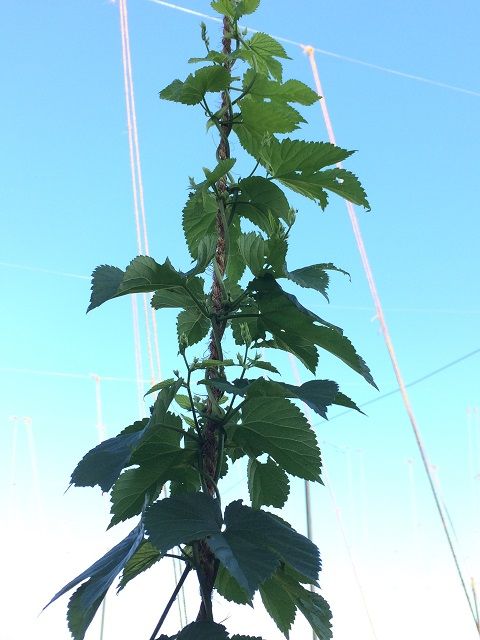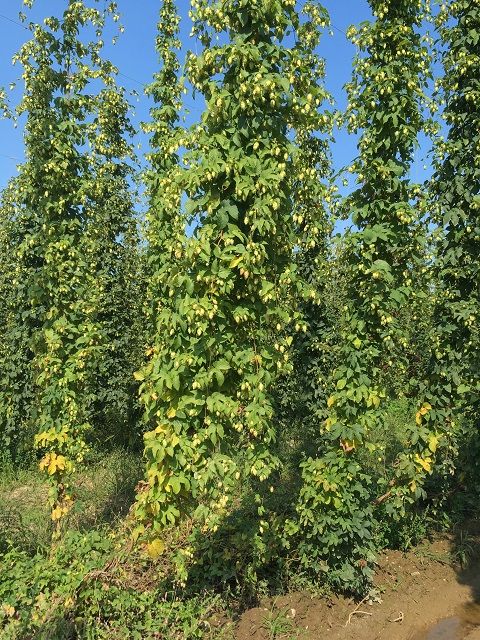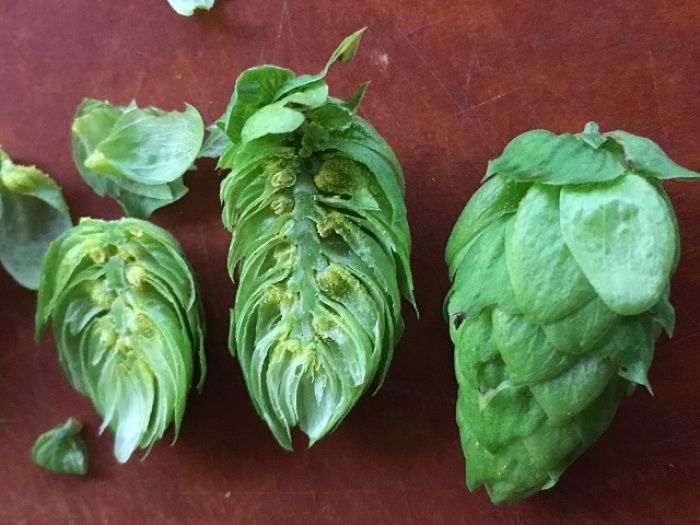
There are a variety of different names for parts of the hop plant and things related to hop growing-since there are so many terms hopping about, I decided to do some research and clarify some of these and their synonyms. This blog is adapted from an article that I wrote for Hops, Herb of the Year 2018: Brewing and Beyond.
Bine (alteration of bind 1727) hopbine, hopbind, hop vine, vine
The best example of a bine is the climbing or twining stem of the hop plant; it is more often referred to as a vine (really the two terms are used interchangeably), however in the hop-growing and farming world and the ever-growing hop industry, it is often called a bine.
A bine is not a vine in that it has no tendrils. It is first a flexible shoot growing from the crown or rhizome and then a sturdy, twining (or vining) stem, which is covered with stiff hairs that allow it to “grab” onto whatever it is growing upon. As it grows, it circles around its support, be it a trellis, pole or other plants in order to grow upwards; its stem is spiral shaped and has a clockwise growing habit. Hops can become quite bushy and the bines can become heavy with weight.
On the other hand, the stem of a vine usually does not twist-it grows upwards vertically and it sends out tendrils, runners and suckers, which facilitate in its twining and climbing habits. The stem does not have to hold the full weight of the plant. Think here of a grape vine-it has a trunk (often quite thick with age) and it is generally trellised so that it can send out tendrils and runners along wire supports. Vines can grow clockwise or counter-clockwise (ie: bindweed grows clockwise while honeysuckle grows counter-clockwise); it depends on the type of plant.
When I googled “What is the difference between a bine and a vine?” I found the following link of interest:
https://dengarden.com/gardening/What-is-the-difference-between-a-bine-and-a-vine. Although, we all know that we can’t rely on what we read online, I found the following quote in this article: “Beer uses Bines, Wine uses Vines”. “To help you remember the difference between a bine and a vine, think of beer and wine making. Hops, which are used to flavor beer, are an example of a bine. Grapes, which are used to make wine, are an example of a vine.”
The two main differences that you can take away here are: bines have a twisting stem and use their stiff hairs to adhere to and totally wrap around a support, while vines have a vertical stem and use tendrils and runners to reach out and grab a support. However, they have been called hop vines for centuries and either term can be used.
Strobile strobiles, hop inflorescence, hop cone, cone, catkin, hop flower, hops flower, strobilus (plural strobili)
A strobile is defined by Merriam Webster as: “1. [New Latin strobilus]: strobilus. 2: a spike with persistent overlapping bracts that resembles a cone and is the pistillate inflorescence of the hop.”
This hop inflorescence-the female flower-is a cone-like structure, thus the reason why they are often called name hop cones. (Imagine a very small, light yellow-green pinecone that is soft in texture-resembling a catkin and suggesting a flower in a hue of pale green.) Hops are dioecious (“two houses” or separate sexes) with male bines bearing male flowers in loose axillary clusters, while females are conelike in shape at maturity and are used in making beer.
These cones or strobiles range from about 1-to 2-inches long, they are oblong in shape and somewhat rounded and they are made up of a number of overlapping bracts attached to an axis (anatomically a stem), also known as a strig or a rachis. The strig, as it is often called by hop growers, is where the hop strobile attaches to the bine, sometimes referred to as a footstalk or pedicel. This strig or main stem of the flowering cone contains tannins and also bitterness.
Within the bracts there are smaller bracts (bracteoles) and therein are small glands that are called lupulin glands. The lupulin looks like a yellow powder and contains resins and essential oils-this is what gives hops their bitter flavor and medicinal virtues-and the more of this yellow substance in a hop strobile, the better!
Now that you know some of the anatomy of Humulus lupulus, the next blog will be on how to grow and harvest your own hops!





















Comments
Log in or create an account to post a comment.
Sign up Log in